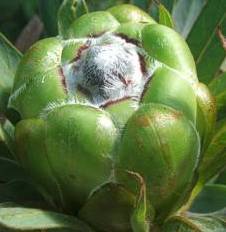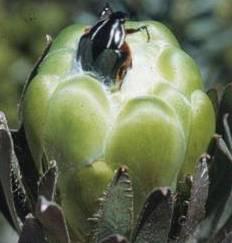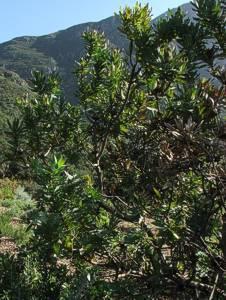Protea coronata
Protea coronata Lam.
Family: Proteaceae
Common names: green protea, green sugarbush (Eng.); groenhofiesuikerbos (Afr.)
SA Tree No: 91.1
Introduction
Protea coronata has bright apple-green inflorescences hidden amongst its silvery foliage; it's not a showy garden shrub but the very attractive and most unusual flower heads are wonderful in floristry. It is also one of those species that remains relatively unknown to gardeners because its camouflaged green flower heads often go unnoticed.

Description
Description
Protea coronata is an upright, rather untidy shrub, 2-3 m tall, becoming a sparsely branched, small tree up to 5 m high. Leaves are upward-pointing, narrowly lance-shaped, green to bluish green, sometimes turning purplish around the flower head, and sparsely covered in long shaggy hairs, giving them a silvery sheen, and becoming hairless with age. Young growth is often attractively tinged red or coppery.

The Protea flower is not a flower but a flower head or inflorescence, made up of many individual flowers grouped together on a rounded base or receptacle. What appear to be the ‘petals’ of the protea ‘flower’ are actually modified leaves known as floral or involucral bracts. Inside the cup of floral bracts are many long, narrow flowers massed together in the centre. Each flower is made up of a perianth of 4 segments, 3 of which are fused to form a sheath. When the flower opens, the fourth falls free, exposing the style. The anthers are in a slight depression near the tip of the perianth segments.
Protea coronata inflorescences are oblong, deeply cup-shaped, 90-100 mm long and 50-60 mm in diameter. The floral bracts are bright apple-green with a dense fringe of silky white hairs along the margins. The flowers are 70-90 mm long, the tips of the perianth segments are covered in white, woolly-cobwebby hairs and the flowers protrude beyond the floral bracts to form the distinctive circular bump at the tip of the flower head.
In some plants the central mass of protruding flowers is pure white, in others it has a black or dark reddish brown tinge (caused by the colour of the perianth segments underneath the white beard), and in some plants there is a dark reddish brown ring around the central mass (caused by markings on the top edge of the floral bracts). Flowering takes place from autumn until spring (April-September) peaking in late autumn and winter (May-July).
Protea coronata is one of the bearded proteas, the beard being the dense fringe of long hairs on the floral bracts. The other typical characteristics of bearded proteas is the way the floral bracts curve inwards, and the bearded perianth segments don’t fall away when the flowers open but remain upright. Because of this, it appears as if the flower heads don’t open, and it is difficult to tell a fresh flower head from an older one. In a fresh flower head the flowers will be clean and white, and more tightly massed. As the flowers open, they puff out and loosen up, and as the flower head ages, they turn more brown and less puffy white. Other bearded proteas covered in this series include P. neriifolia and P. lepidocarpodendron.
Protea coronata is easy to recognize as there really is no other protea like it.

Conservation Status
Status
Protea coronata is not threatened. It typically occurs in dense stands and has weedy tendencies in that it often appears on fallow land adjacent to wild populations and along road verges.
Distribution and habitat
Distribution description
Protea coronata occurs in the west, south and southeast of the Western Cape and into the Eastern Cape, in three distinct blocks and with two large gaps in its distribution range. In the west, it occurs on the Cape Peninsula and Du Toit's Kloof to the Kogelberg, Riversonderend, the Bredasdorp Mountains and Potberg. In the middle part of its range it occurs in the eastern Langeberg and Outeniqua Mountains between Riversdale and George. The most easterly populations occur in the eastern Tsitsikamma Mountains near Humansdorp and in the Suurberg. These gaps occur most likely because of its soil and moisture preferences. Unlike most proteas it prefers heavy clay soils and fairly high rainfall. It is found growing in soil derived from Malmesbury shale, decomposed Cape granite, shale bands in Table Mountain sandstone and on Bokkeveld shales. It forms dense stands on the lower or middle slopes between 200 and 750 m, often in tall, moist fynbos on forest margins or in damp, sheltered kloofs. Its tolerance for heavy soils and high moisture make it well suited to cultivation in most gardens.
Derivation of name and historical aspects
History
The genus Protea was named by Linnaeus after the Greek god Proteus who could change his form at will, because the proteas are so different in form. Coronata means crowned, from the Latin corona, meaning crown, garland or wreath, referring to the way the tips of the flowers project beyond the floral bracts forming a white woolly crown at the top of the flower head.
The Proteaceae is an ancient family. Its ancestors grew in Gondwanaland 300 million years ago. The family is divided into two subfamilies, the Proteoideae, best represented in southern Africa, and the Grevilleoideae, concentrated in Australia and South America and the other smaller segments of Gondwanaland that are now part of eastern Asia. In Africa, no species occurs further north than the Limpopo River, and 92% of the species occur only in the Cape Floristic Region, a narrow belt of mountainous coastal land from Clanwilliam to Grahamstown. The extraordinary richness and diversity of species characteristic of the Cape flora is thought to be caused in part by the diverse landscape where populations can become isolated from each other and in time develop into separate species.
Protea coronata was first mentioned in botanical literature in 1720 when an illustrated account of it was published by Boerhaave. It did not attract much attention and was only introduced into cultivation in England in 1822.
Ecology
Ecology
Protea coronata is visited by the Cape sugarbird and sunbirds, and by many insects, including the protea beetle. The birds feed on the nectar while the insects come in search of nectar and pollen. Only the sugarbird and the protea beetle are the pollinators. Nectar is found at the base of each flower. To get to it, the sugarbird has to push its head between the massed flowers to reach the nectar at the base; while doing this, pollen is rubbed off onto the bird’s head. It then flies off to another bush and transfers its load of pollen to another flower while it picks up some more. The protea beetles are large and brush the pollen onto themselves as they move through the flower head.

The sunbirds are not pollinators, they ‘cheat’ by sticking their beaks into the side of the flower heads straight to the base of the flowers, bypassing the pollen. Many insects visit protea flower heads; take a look inside or turn one upside down and tap the side a few times and see how many fall out. Some are pests, damaging the flower or eating the seed, but most are there to feed on the pollen or each other and may also be extra food for sugarbirds and sunbirds.
Fynbos is fire-prone and most plants have adopted a re-seeding or resprouting strategy to survive frequent fires. Protea coronata is a re-seeder, it produces large amounts of seed and although killed by a fire, it is quick to recolonise from seed after a fire. It is also fast-growing and relatively short-lived and is known to be a bit weedy, in that it spreads onto fallow land and road verges adjacent to wild populations.
Protea seeds are covered in long hairs. These hairs aid in dispersal and germination: by expanding as the flower head opens, forcing them out of the head; once they are out, the hairs allow the seeds to be more easily moved by the wind; and once they land on the soil the hairs help to anchor the seeds in to the ground; and finally, the hairs help orientate the seed the right way round and channel water towards it.
Uses
Use
Protea coronata makes an excellent and much sought-after cut flower and is cultivated for the cut flower trade. However, it is a difficult subject for the export market because it seems to attract more than its fair share of insects, particularly thrips. Protea coronata is also used in the dry-flower trade, here the woody flower bases are dried and sold as protea rosettes or 'protea daisies'.

Growing Protea coronata
Grow
The green protea is an interesting addition to the fynbos garden, but is equally at home in gardens outside of the winter rainfall area as it tolerates a wider range of soils than most proteas. It is not the showiest specimen shrub, but its silvery foliage is useful for providing contrast, and its fast growth will quickly provide height as a backdrop. It is a very unusual and attractive cut flower.
Protea coronata is easy to grow in most garden soils, including heavy clay soils, provided they are acidic (pH7) and well drained. It can be planted in full sun or in a situation that is shaded for part of the day, but needs free circulation of air. The more shaded and sheltered its position, the more likely fungal infections will afflict the foliage and flowers. Water well throughout the year but particularly in autumn-winter-spring. Keep root disturbance to a minimum; protea roots are very susceptible to infection so try not to break them by digging around their base inside their drip-line, rather put down a thick layer of mulch once or twice a year and leave them undisturbed. Proteas are very light feeders with sensitive root systems that are adapted to very nutrient-poor soils and will be killed by strong fertilizers and manure. Proteas don't like phosphates (P), so choose a fertilizer that has little or no P in its formula, and give them small doses more frequently, or use a slow-release fertilizer. Protea coronata is fast-growing and vigorous, flowering in its second year from seed and reaching 2 m in four years. It is also relatively short-lived and is best replaced after about 8 years. This species is tolerant of light frost and a winter minimum of -1° C (30° F), and is not suited to very cold gardens.
Protea coronata is easily raised from seed sown in autumn, in well-drained soil, lightly covered with clean sand or fine-milled bark and kept moist but not wet. Germination occurs after about 20-30 days. Treating the seeds with a fungicide increases the number of surviving seedlings. Transplant into individual containers as soon as the first pair of true leaves have developed. Seedlings are vigorous and fast-growing, and the first flowers can be expected in their second year.
It can also be propagated by semi-hardwood cuttings taken from the current season’s growth, in autumn or spring. Remove the leaves from the basal third of the cutting, treat with a rooting hormone, and place in a well-drained rooting medium under intermittent mist with bottom heat of 25° C.
References
- Goldblatt, P. & Manning, J. 2000. Cape plants. A conspectus of the Cape flora of South Africa. Strelitzia 9. National Botanical Institute, Pretoria & Missouri Botanical Garden, Missouri.
- Rebelo, A. (Tony). 2001. Proteas. A field guide to the proteas of southern Africa, edn 2. Fernwood Press, Cape Town.
- Rourke, J.P. 1982. The proteas of southern Africa. Centaur Publishers, Johannesburg.
- Vogts, M. 1982. South Africa 's Proteaceae. Know them and grow them. Struik, Cape Town.
- website: Protea Atlas Project. http://protea.worldonline.co.za.
Credits
Alice Notten
Kirstenbosch National Botanical Garden
September 2008
Plant Attributes:
Plant Type: Shrub
SA Distribution: Eastern Cape, Western Cape
Soil type: Sandy, Clay, Loam
Flowering season: Spring, Autumn, Winter
PH: Acid
Flower colour: Green
Aspect: Full Sun
Gardening skill: Average
Special Features:
Horticultural zones











Rate this article
Article well written and informative
Rate this plant
Is this an interesting plant?
Login to add your Comment
Back to topNot registered yet? Click here to register.